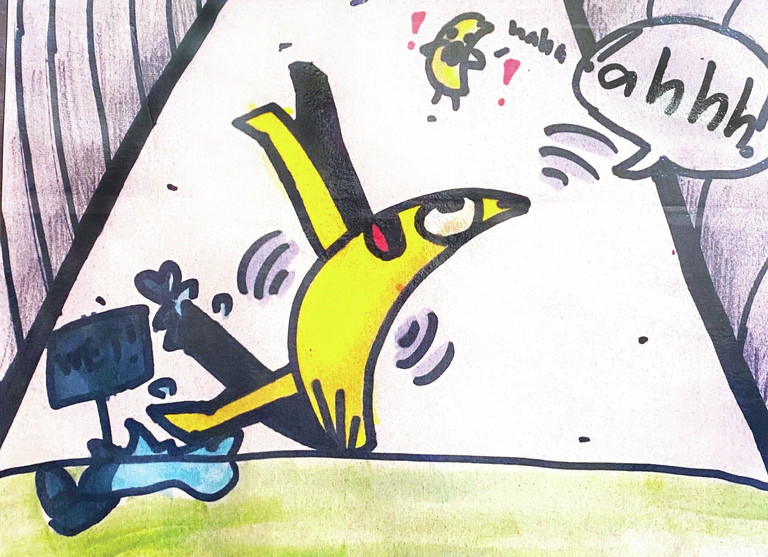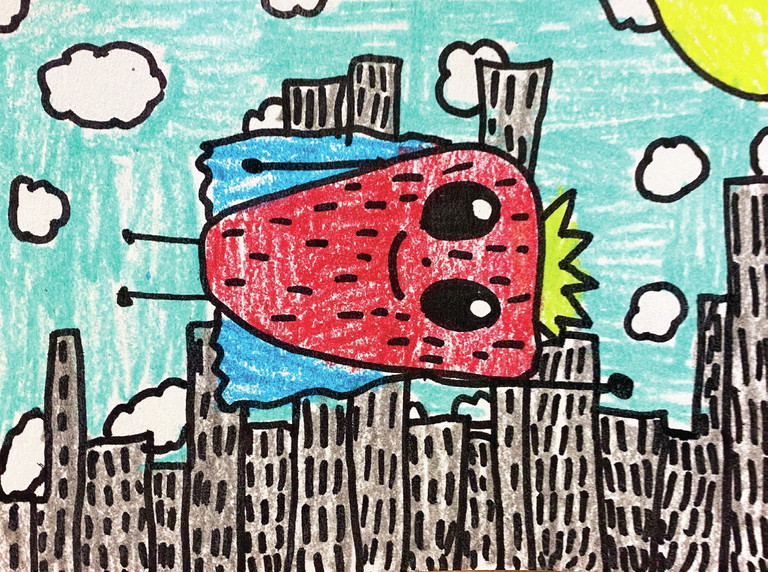ELEMENTARY

Amelia, Foodles-inspired drawing.
Jessica Apple
Imagine a classroom where students are not only taught to create art, but are also challenged to unleash their wildest creativity while gaining confidence in their drawing abilities. I was looking for a way to achieve exactly that for my elementary art room when I discovered an exciting game that ultimately inspired my classroom drawing challenges.
In this article, weʼll explore the idea of integrating wacky drawing challenges as a daily activity to motivate students to push their creative boundaries. “Foodles,” or food doodles, are not your typical drawing activity; they are inspired by the drawing game Foodles from the Imagineering Company. By integrating foodles into the art curriculum, I provided students with a playful way to challenge themselves creatively.
Basic Concepts
When they enter the art room, students are greeted with a quirky prompt that serves as their early finisher project. Although the Foodle game inspired this activity, the daily prompts originate from the creative minds of the teacher and any students interested in contributing ideas. These prompts range from “flying bacon” to “an apple at the beach”; the only requirement is that they incorporate food in some way.
This lighthearted activity provides a creative playground where young learners are free to draw and imagine without worrying about being “right” or “wrong.” The idea is simple: students use small 4 x 5" (10 x 12.5 cm) pieces of paper to draw their own interpretations of the daily prompt.
Artistic Inspiration and Principles
During the introduction of this idea, I connect this concept with surrealism, an artistic movement based on fantasy and dreams. Surrealism, led by André Breton, emphasizes freedom of thought and expression by encouraging artists to express themselves through unconventional forms.
By integrating foodles into the art curriculum, I provided students with a playful way to challenge themselves.
When we analyze artworks like The Portrait by René Magritte (1935), we see that the artist employed composition and juxtaposition to create a thoughtprovoking and visually engaging piece. Magritte added a striking element to his painting—a slice of ham with an eye. This peculiar and unexpected combination challenges conventional expectations of ordinary objects.
Embracing this freedom of thought and expression while still incorporating principles of art allows students to create whimsical drawings as they continue to practice composition, unity, and balance. Not only are students drawing without inhibitions, but they are also learning how to arrange elements within their artwork, creating visual harmony.
Prompt Exploration
Students begin by exploring the daily prompt. This step encourages them to think creatively and embrace the unexpected. At first, they might struggle with the unconventional nature of the prompt, but after some guidance, students learn to embrace the freedom offered to them.
For example, one student worried about drawing “correctly” and felt lost when confronted with the prompt, “a singing corn on the cob.” After a reassuring chat when we talked about there being no right or wrong way to approach this prompt, this student conjured up a vibrant scenario: a corn on the cob taking center stage, belting out tunes to an eager audience.

A drawing based on the prompt “flying strawberry.”
Imagination and Artistry
Students craft imaginative scenes, giving life to their unique interpretations, conveying abstract concepts, and telling stories. Take, for instance, the prompt “flying strawberry.” One student might envision the strawberry hurtling across a cafeteria while another student might infuse it with superhero flair as it zooms above the city.
Students apply fundamental principles of art, emphasizing composition, movement, and space. They prioritize conveying their intended message to the viewer while they uphold a high level of artistry, reviewing their work for overall quality. They have the option to continue working on incomplete pieces outside of class.
Display and Assessment
These drawings are never homework, but students can’t resist completing them. Why? Because they strive to make it onto the Foodle Wall of Fame, which allows the school to celebrate exceptional pieces from kindergarten through fifth grade.
Assessment is based on artistry, inclusion of the prompt, and overall balance of the composition. In addition to the Foodle Wall of Fame, each year the two best foodles get turned into posters and become part of the art room’s permanent collection.
Beyond the Classroom
Some students have continued to explore their ideas at home, using their initial drawing as a launching point to create a short story. Other students have continued to create foodle-inspired art in their personal sketchbooks.
By embracing the unconventional, students are able to gain conf idence in drawing and unlock the true power of their imagination. This gives students the skills to enter a world of self-expression and limitless creativity. So, jump in and give whimsical drawing challenges a try. You might even find that you enjoy drawing them as much as your students do!
NATIONAL STANDARD
Creating: Conceiving and developing new artistic ideas and work.
Jessica Apple is an art teacher at Brushy Creek Elementary School in Greenville, South Carolina. japple@greenville.k12.sc.us